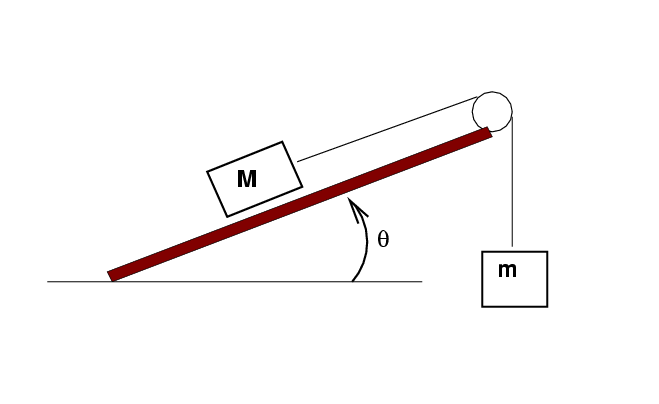
 Copyright © Michael Richmond.
This work is licensed under a Creative Commons License.
Copyright © Michael Richmond.
This work is licensed under a Creative Commons License.
The goal of today's experiment is for you to determine
Clean your track gently with a damp paper towel, then dry it off. Tilt it at an angle of between 3 and 5 degrees; any value in that range is okay, just make sure you measure it properly and stabilize the track so it won't move. Place a cart on the track. Connect this cart to a hanging mass (use the blue mass sets) via a pulley.

Add mass to the cart in the following manner:
Measure the mass of the cart and all its cargo on a scale. We'll call this cart mass M.
Add weights to the hanger so that its total mass is about 115 grams; we'll call the hanging mass m. Adjust this hanging mass so that the cart will slowly roll up the ramp, taking about 5 seconds to cover a distance L = 60 cm.
Your job is to measure the acceleration of the cart up the track. In each case, you'll measure the time it takes for the cart to travel L = 60 cm, and you should make three trials for each case. The trick is that you will make measurements while varying the mass of both the cart and the hanger, by transferring pennies, one at a time, from cart to hanger. So, you should make measurements with:
In every case, the time it takes for the cart to roll L = 60 cm should be more than 2 seconds. Check with the instructor if you can't make this happen.
Make a table of your all your measurements, showing the cart mass M and hanging mass m as well as the times and accelerations.
Preliminary analysis:
Use algebra to put your equation into a form that looks like this:
acceleration = ( some stuff ) * m + ( other stuff )
Now, the first term on the right-hand side changes when you add pennies to the hanger, because m gets bigger; but the second term doesn't change (much) at all as you move pennies. That means that if you make a graph which has hanging mass m on the horizontal axis, and acceleration on the vertical axis, the slope of a line through your data should be equal to the "(some stuff)" term.
Your value may not be very accurate, due to a not-quite-valid assumption made in the paragraph above. Can you explain?
Use algebra to put your equation into a form that looks like this:
(some stuff) - (some other stuff)
mu = --------------------------------------------
(stuff on the bottom)
In this case, you won't make any approximations. Adopt the proper value for g = 980 cm per second per second , and make a neat table. For each trial of your measurements, compute a value of mu. I had three trials each for seven different mass combinations, so a total of 21 values.
After you have finished, compute a mean value and an uncertainty for this coefficient of rolling friction. The uncertainty in my value was about 15 percent; can you do as well?
Each group must submit a single lab report at the start of our next class (it's okay to hand it in earlier, of course!). The lab report must contain
I will judge each report on a number of criteria, which include grammar, spelling, and neatness.
 Copyright © Michael Richmond.
This work is licensed under a Creative Commons License.
Copyright © Michael Richmond.
This work is licensed under a Creative Commons License.